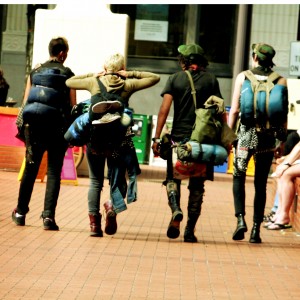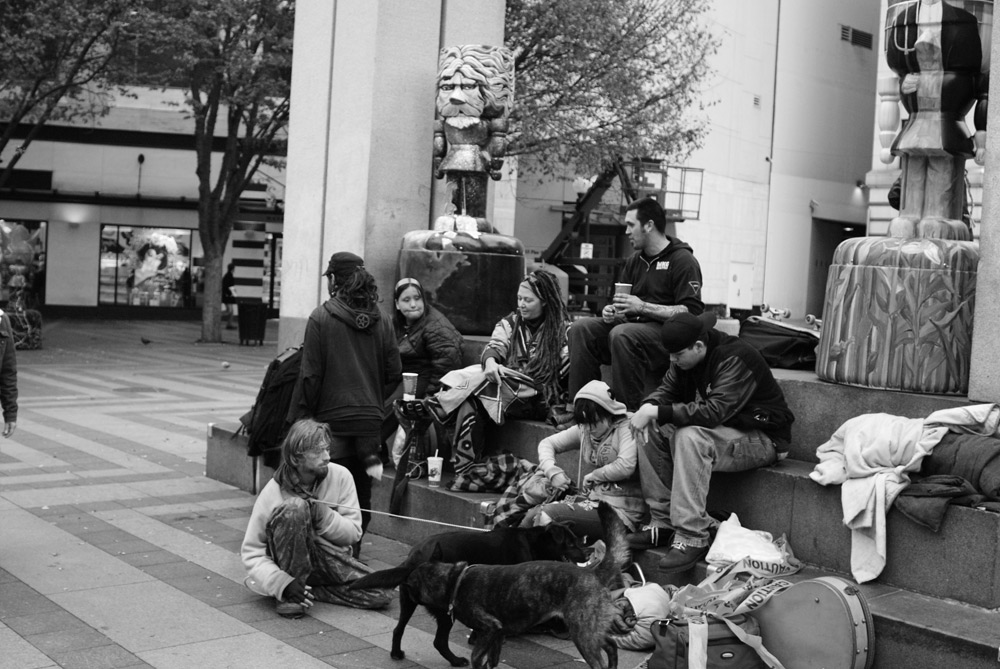Homeless in High School: Interview with Bob Grovenburg

Youth homelessness is a social and public health issue that frequently goes overlooked by members of the community. A former homeless teen himself, Bob Grovenburg has spent the majority of his life teaching homeless students their value. His message: with community support, encouragement, and plenty of hard work, a bright future will be in store.
Bob Grovenburg's initial story is, sadly, not uncommon: he left home at a young age due to domestic violence and alcoholism within his family. He was homeless for the next thirteen years and dealt with addiction issues of his own. Falling in and out of jail, Bob got clean when he was 27 years old. That is when his life turned around: he began working for the Community Alcohol and Drug Center in Vancouver, Washington. Bob developed a comprehensive community-based program in Clark County for the school district and juvenile courts. He also consulted with treatment programs in southwest Washington and the Portland metro area to expand school-based programs and treatment programs for both inpatient and outpatient facilities. Even hospitals in Portland have consulted him to teach their staff how to better provide assistance when dealing with patients checked into their emergency rooms for drug- and alcohol-related situations.
Driven by a desire to be an active part of his community, Bob has held roles as a treatment coordinator for several inpatient and outpatient treatment programs, worked with men dealing with co-dependency issues, and led large groups of people seeking spiritual self-awareness through Native American practices. Bob has also served as a board member on various community nonprofit boards. During the last 25 years, he has given his all to the Parkrose School District as the D/A Counselor Homeless Liaison and alternative school counselor.
Josh Gordon: As a guidance counselor, what were some issues that you commonly faced?
Bob Grovenburg: We were a small district; we had about 3,500 students district-wide. For the past 15 years we averaged 220, maximum 250 homeless students in our district, about half of the students in high school and the other half in middle or elementary school.
J: Is homelessness a major issue in Portland?
B: Every school district in the United States is mandated by the federal government to have a homeless student liaison. So every school district in the Portland area has somebody in my position, which is also known as the Title X Liaison. In Multnomah County, we had monthly meetings where all of us from the different districts got together. In my 15 years in that position, it averaged around 5,000 kids per year that were in some form of homeless situation. I’m sure the number is larger than that; this number is just how many of these kids were enrolled in school.
J: Did they have extra programs for these kids to keep them on track, or was the function primarily for a head count?
B: It depended on the district. Initially, when the programs first started, the districts got on track right away. The economic climate was different back then and it was relatively easy to recruit support in the communities and to do fundraising activities. In my district, for the first seven to eight years, we furnished transportation to and from school. We bought the majority of the clothing that the kids needed, all of their school supplies, and if they wanted to do any extracurricular activities, we paid all of the fees. We did the best that we could to ensure that their school experience in our district was no different than any other student’s. I was raising anywhere between $30,000 – $60,000 from local businesses and faith-based organizations, but after the economic downturn, that dropped down to zero and the level of service dropped down as well. My primary job was to make sure that kids were enrolled in school and that they weren’t turned away.
One of the biggest issues with homeless kids is lack of documentation. So if they walked into a school and they didn’t have records from another school, a birth certificate, or a proof of address, they were turned away and weren’t allowed to enroll. I would say 90% of my job was making sure that the kids were able to have a seat in school the day that they walked into the building.
J: Do you feel a lot of the kids made a better situation for themselves because of this program? Maybe some went on to college or found a job to break their cycle of homelessness?
“One of the issues with kids who experience homelessness for any length of time is that they want a sense of security, and the fastest way for them to do that after high school is to go get a job and start making a means for themselves.”
B: It depended on the situation, the kid, and the family more than anything else. I would say that probably a quarter of the kids were out of family systems that experienced some form of homelessness and instability, sometimes even for up to three generations. Because it was a public school, there were certain things we didn’t keep records on, but my background as a drug and alcohol counselor and the relationship that I had with the kids enabled me to know that a good half of the kids I enrolled were out of drug addicted family systems and domestic violence situations. Those kids, they were the hardest to keep in school. But the kids who we were able to keep in school, graduated. The vast majority of them went on to junior college, four year universities, some kind of vocational training, or went out to get a job. One of the issues with kids who experience homelessness for any length of time is that they want a sense of security, and the fastest way for them to do that after high school is to go get a job and start making a means for themselves.
J: So this program really gave them the opportunity to boost themselves out of their situation.
B: Nobody kept records of kids who weren’t enrolled in school prior to this federal law being passed. But I know from my experience that probably every year, say, if we had 80 kids at the high school who were homeless, if we had twenty graduating seniors, I know that fifteen out of that twenty wouldn’t have stayed in school long enough to graduate if the program hadn’t been there.
 J: Did you ever deal with students who had drug issues of their own?
J: Did you ever deal with students who had drug issues of their own?
B: The majority of the students had some level of drug or alcohol use.
J: How did you approach that?
B: My first responsibility — it wasn’t a responsibility that was dictated by my job description or anything, but my first responsibility was to develop a relationship with the kids as fast as I could. The majority of the kids who were on the homeless list spent a significant amount of time with me because they trusted me and knew I genuinely cared about them. There were groups at the high school that I ran for kids who were either living with alcoholism and drug addiction and didn’t have a problem of their own, or who did have an issue and wanted to deal with it. The thing that’s lacking in most communities is support outside of school for kids who have drug and alcohol issues. You know, there are treatment programs, but I know from my own experience that what is available in communities today is sadly lacking.
J: What would be the ideal environment for these kids to thrive?
B: One of my dreams was to have a dormitory. I’ve always thought that every community should have a dormitory for homeless kids, because one of the hardest things for a kid to do in that situation is to find a place to sleep. In the case of most homeless kids, they are not on the street. The majority aren’t living with a parent, but staying wherever they can through their network of peers. Every night they may have a place to sleep, but they move a lot between different families and friends, and one of the hardest things for them to do is to keep their school supplies together. They are constantly losing their supplies and clothing either by misplacement or by theft. These kids don’t even have a place to study. So what I always I wanted, especially in my last years involved in the program, was a dormitory. These kids need a place. I think that in most communities, the average person believes that there are foster homes and group homes available for every kid who wants them, and that is not the truth by any stretch of the imagination. Another problem from the homeless kid’s perspective about being placed in a group or foster home is that they’re being punished for the situation that they were born into through curfews and other various rules. They’re being prodded to see the world through different eyes than they’re used to.

J: In Seattle, there is a huge homeless youth population. I see young people sleeping on the street all of the time and no one addresses it, they just ignore it.
B: In every major metropolitan area, there is a large population of homeless street kids. But in all honesty, those are the kids who aren’t likely in school. It’s almost like there are two different populations of homeless kids, and neither get counted in the same groups. The vast majority of [homeless] kids who are in schools usually have a place to stay each night, because they are in class with other kids and kids care about each other. In every community, there are parents who will take a child in. The problem is the lack of consistency which sometimes forces kids not to go through with their education, and that is the one thing that they need to take them out of this circumstance. I’m not sure about the Seattle area, but I know that in Portland almost all of the services for homeless youth are located in the downtown area. The majority of the kids from the outlying areas are scared to death of going downtown; they don’t want to be around the street kids who live there, the violence, and the level of addiction that is so prevalent in that population. My experience based on conversations with people from Oregon, Washington, and all over the country is that it seems like the majority of services are located in downtown areas, which drives kids into two different homeless groups.
J: How did you successfully instill motivation in these children?
B: My experience was that there was always a pool of kids who, for whatever reason, had a better grasp on the world and what they needed to be successful. They had the drive or desire to go that extra mile to get what they needed to get out of the situation that they were in. At the same time, there is a level of depression and disillusionment in these kids that requires daily contact and somebody to spend time with them and reinforce that through hard work, things get better. It is unfair in that situation but it is what it is, and these are the things you need to do if you want out of it.
J: So you helped them understand that they are in control of their own lives, and to make choices to create a better future for themselves.
“There is a level of depression and disillusionment in these kids that requires daily contact and somebody to spend time with them and reinforce that through hard work, things get better.”
B: One hundred percent, that’s what I’m all about. It doesn’t matter if it is addiction, drug abuse, or homelessness; they are the key to getting themselves out and making a better life for themselves.
J: How can the community get involved and take action or contribute some of their time and resources to these programs?
B: Like I said, every school district has somebody in my position. Depending upon the district and their level of buy-in, a lot of districts just go by the law that you have to enroll them and count them. I think a lot of districts are turning around and realizing that they have to do a little bit more than that to keep these kids in school. If anyone wants to get involved, they need to contact the school district and get ahold of the homeless youth liaison in that district, and ask them what is needed.
I can tell you the thing that is needed the most is money. It makes a huge difference. When you have to wake up and put on the same set of clothes you’ve been wearing since a week ago, and you have to walk into a high school and you know just as well as I do that there isn’t any group in the world more judgemental than high school kids. They don’t feel equal and are already lacking in hope and self esteem. One of the things that I always tried to do, as superficial as it sounds, was to buy gift certificates to give to the kids. That way, they could go to the store and buy something that they liked. They could feel ownership over that and feel better about themselves. I didn’t want them to only have things that were donated and worn by somebody else’s kids. I wanted to let them build their own self esteem. People can say it is superficial all they want, but I invite them to look back on their own high school memories and recall some moments where they felt judged by everyone else.
J: I’m sure that having their own stuff helped them feel ownership over their own lives, and they probably felt included in their school.
B: I just know that a new set of clothes and new school supplies can have a dramatic impact on their willingness to go to school. In the years that I ran the program, it wasn’t uncommon for me to get kids who had been to multiple schools in that year alone, and the vast majority of kids who were enrolled in our district in a homeless situation didn’t want to leave our district. In fact, I had kids who refused to move with their parents when their parents decided to go somewhere else, just because they knew they were cared about here. It wasn’t just lip service, it was also the material things that kept them here. It made them feel like they mattered, and that’s the biggest issue with these kids — they don’t feel like they matter.
J: Just for a quick re-cap, where should people donate money to if they want to lend a hand?
B: Money that is donated to a school can be used for anything. It is important that the money is sent directly to the homeless liaison for the school district — this will ensure that the money goes right into the program.
J: Thanks, Bob, for all of your time!
B: You bet!

